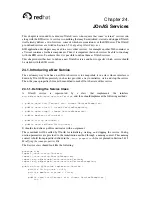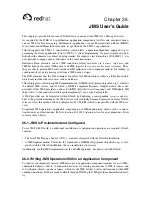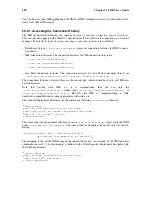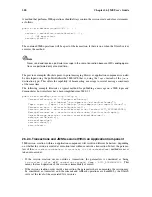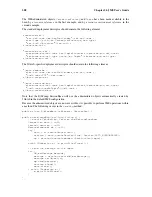
Chapter 25.
JOnAS and the Connector Architecture
This chapter is provided for advanced JOnAS users concerned with EAI (Enterprise Application In-
tegration).
25.1. Introducing the Connector Architecture
The Java Connector Architecture (Connectors) defines a way for enterprise applications (based on
EJB, Servlet, JSP, or J2EE clients) to communicate with existing external Enterprise Information
Systems (EIS) through an application server such as JOnAS. This requires the use of a third-party
software component called a Resource Adapter (RA) for each type of EIS. A Resource Adapter is an
architecture component, comparable to a software driver, that connects the EIS, the application server,
and the enterprise application. The RA is generally made available by an EIS vendor.
The RA provides an interface (the Common Client Interface or CCI) to the enterprise application
(EJBs) for accessing the EIS. The RA also provides standard interfaces for plugging into the applica-
tion server, so that the EIS and application server can collaborate to keep all system-level mechanisms
transparent from the application components. The application performs “business logic” operations
on the EIS data using the RA client API (CCI), while transactions, connections (including pooling),
and security on the EIS is managed by JOnAS through the RA (system contract).
Figure 25-1. Connector Architecture
25.2. Defining the JOnAS Connector Deployment Descriptor
Using a Connector Resource Adapter with JOnAS involves the following steps:
1. The bean provider must specify the connection factory requirements by declaring a
resource
manager connection factory reference
in its EJB deployment descriptor. For example:
Summary of Contents for Application Server
Page 1: ...Red Hat Application Server JOnAS User Guide ...
Page 8: ......
Page 22: ...14 Chapter 1 Java Open Application Server JOnAS a J2EE Platform ...
Page 58: ...50 Chapter 3 JOnAS Configuration ...
Page 66: ...58 Chapter 5 JOnAS Class Loader Hierarchy ...
Page 78: ...70 Chapter 6 JOnAS Command Reference ...
Page 80: ......
Page 86: ...78 Chapter 7 Developing Session Beans ...
Page 136: ...128 Chapter 9 Developing Message Driven Beans ...
Page 142: ...134 Chapter 10 Defining the Deployment Descriptor ...
Page 148: ...140 Chapter 11 Transactional Behavior of EJB Applications ...
Page 158: ...150 Chapter 14 EJB Packaging ...
Page 162: ...154 Chapter 15 Application Deployment and Installation Guide ...
Page 164: ......
Page 176: ...168 Chapter 18 WAR Packaging ...
Page 178: ......
Page 184: ...176 Chapter 20 Defining the Client Deployment Descriptor ...
Page 186: ...178 Chapter 21 Client Packaging ...
Page 188: ......
Page 192: ...184 Chapter 23 EAR Packaging ...
Page 194: ......
Page 200: ...192 Chapter 24 JOnAS Services ...
Page 204: ...196 Chapter 25 JOnAS and the Connector Architecture ...
Page 222: ...214 Chapter 27 Ant EJB Tasks Using EJB JAR ...
Page 234: ...226 Chapter 29 Web Services with JOnAS ...
Page 236: ......
Page 260: ...252 Chapter 34 How to use Axis in JOnAS ...
Page 270: ...262 Chapter 36 Web Service Interoperability between JOnAS and BEA WebLogic ...
Page 296: ......









